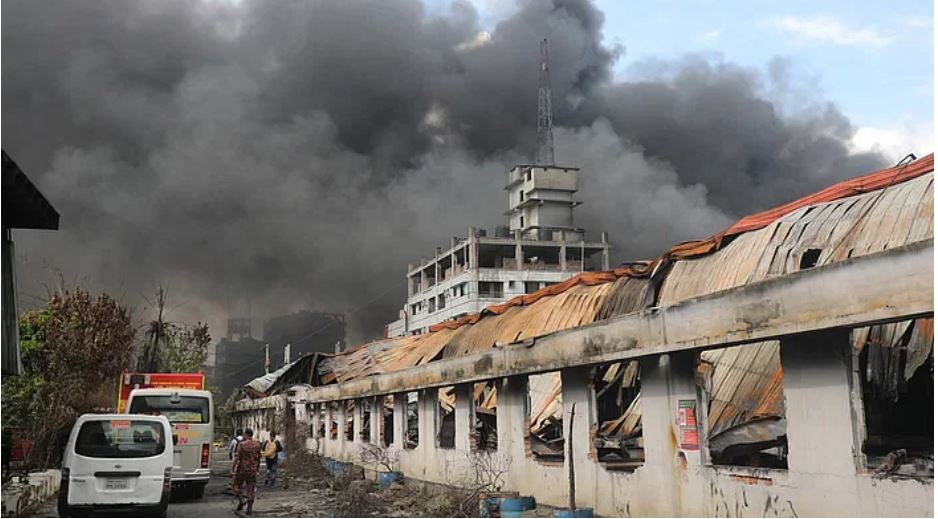A catastrophic fire at the Gazi auto tyre factory in Rupshi, Narayanganj, near Dhaka, has resulted in a significant loss of life and highlights severe safety and security issues in industrial settings. The blaze, which erupted on August 25, 2024, has been described as one of the most tragic industrial disasters in recent Bangladeshi history. This incident has drawn widespread attention due to the scale of the fire, the circumstances surrounding it, and the involvement of a large, unruly mob.
Background on the Gazi Tyre Factory
The Gazi tyre factory, owned by Golam Dastgir Gazi, was a prominent establishment in Bangladesh’s industrial sector. Gazi, formerly the Minister of Textile and Jute under Prime Minister Sheikh Hasina, was a significant figure whose influence extended well beyond the factory. The Gazi group, known for its extensive operations, faced a drastic change in fortunes following political upheaval. On August 5, 2024, the Hasina government’s fall marked a turning point, leading to Gazi’s arrest and subsequent hideout.
The factory’s reputation and the political turmoil surrounding its owner set the stage for a tragic series of events. On August 25, following Gazi’s arrest, a large mob descended on the factory, culminating in a disaster that has shocked the nation.
Details of the Incident
The fire at the Gazi tyre factory began late in the evening on August 25. According to eyewitness reports, a significant crowd, estimated to be several hundred individuals, stormed the facility’s five-story warehouse, which housed large quantities of highly flammable materials. These materials included sulphur, carbon black, and various chemical agents used in tyre manufacturing.
Russel Hossein, a store assistant at the factory, described the scene as chaotic and perilous. He recounted that the crowd, comprised of men, women, and children, entered the warehouse with the intent of scavenging valuable materials. The situation quickly escalated when a fire broke out in the lower sections of the building, trapping those inside. The intensity of the fire was exacerbated by the volatile substances stored in the warehouse, leading to rapid spread and devastating explosions.
Witnesses reported that the fire consumed the building quickly, leaving no chance for escape for those trapped inside. Many individuals who had entered the factory to steal materials were caught in the blaze, unable to get out due to the sudden onset of the fire and the resulting structural collapse.
Response and Aftermath
The initial media reports described the incident as a case of arson targeted at the Gazi group’s property. However, as the scale of the disaster became apparent, it became clear that the situation was more complex. Families of the missing individuals began to gather outside the factory, intensifying the focus on the fire’s human toll.
Sharyar Apu’s father, Mohammed Umar Ali, recounted his son’s visit to the factory that evening. Apu, along with his friends, had entered the premises with the intention of collecting materials, not realizing the imminent danger. Similarly, Khadija Begum reported that her son-in-law had also been among those who entered the factory and was now missing.
The Bangladesh Fire Service and Civil Defence, along with factory guards, have been working to control the situation and manage the aftermath. Reports indicate that numerous individuals made desperate phone calls while trapped, pleading for help. However, due to the intensity of the fire and the hazardous conditions, rescue efforts have been challenging.
Casualty Figures and Official Response
As of August 28, 2024, authorities have confirmed that at least 168 to 178 individuals are missing, with the actual number likely higher. District Collector Mahmudul Haq criticized the lack of effective policing and preventive measures that could have mitigated the disaster. He described the incident as a tragedy that could have been avoided with better control and oversight.
The emotional distress experienced by the families of the victims has been palpable, with many expressing frustration and grief outside the factory gates. The fire has not only caused substantial human loss but has also raised serious questions about industrial safety standards and the enforcement of regulations in Bangladesh.
Broader Implications
The Gazi tyre factory fire highlights several critical issues:
- Industrial Safety Regulations: The need for stringent safety protocols in industrial operations is paramount. The handling and storage of hazardous materials require rigorous standards to prevent such tragedies.
- Emergency Response Preparedness: Effective emergency response systems are crucial in managing large-scale industrial disasters. The delay and difficulties in rescue operations underscore the need for better preparedness and training.
- Socio-Political Factors: The connection between political instability and industrial incidents raises concerns about the broader implications of such events. The involvement of a politically significant figure and the subsequent unrest indicate the intersection of politics and industrial safety.
- Public Awareness and Safety Measures: Increasing public awareness about safety measures and the dangers associated with scavenging hazardous materials is essential to prevent similar incidents in the future.
Conclusion
The Gazi tyre factory fire stands as a stark reminder of the importance of enforcing safety regulations and preparing for emergencies in industrial settings. The tragedy has claimed numerous lives and caused immense suffering for the affected families. As investigations continue and the authorities address the aftermath, the focus must shift towards implementing stronger safety measures, improving emergency response capabilities, and addressing the broader socio-political factors that contribute to such disasters. The incident underscores the urgent need for systemic changes to ensure that industrial safety and public welfare are prioritized in Bangladesh and beyond.
Soumya Smruti Sahoo is a seasoned journalist with extensive experience in both international and Indian news writing. With a sharp analytical mind and a dedication to uncovering the truth, Soumya has built a reputation for delivering in-depth, well-researched articles that provide readers with a clear understanding of complex global and domestic issues. Her work reflects a deep commitment to journalistic integrity, making her a trusted source for accurate and insightful news coverage.



